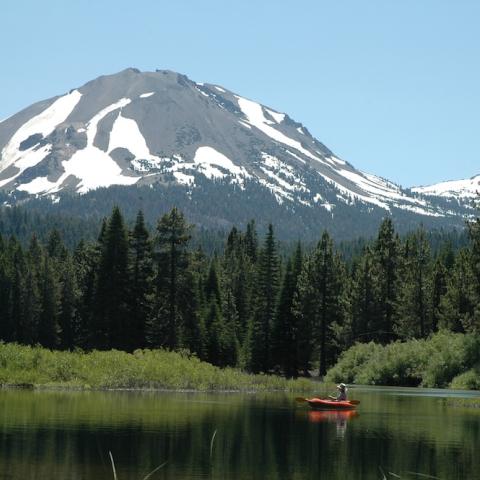
The Dixie Fire was charring a south-to-north swath through Lassen Volcanic Park. The red arrow shows its approximate path from the southern boundary to the southern edge of Butte Lake.
Very little was standing in the way Monday of California's massive Dixie Fire, which was feasting on kiln-dry forests as it charred its way north through Lassen Volcanic National Park, skirting around lakes and to the east of the park's Fantastic Lava Beds.
Fire bosses hope dozer lines will slow the conflagration as it reaches the park's border with Lassen National Forest, though that remains to be seen.
"Right now, there's no place within (the park) where the fire is and the northern boundary to put in that (dozer) line," park spokesman Kevin Sweeney said late Monday morning during a phone call. "The strategy, the box that we built now, is for it to kind of go, and we're strengthening the lines on the north side of the park in the (national) forest where those roads already exist, where we have a better chance of putting in a containment line that would suppress it."
The Dixie Fire, which was spotted July 13, sparked from unknown origin, has been devastating. As of Monday morning it was mapped at 569,707 acres with just 31 percent of its 490-mile-long perimeter considered contained. Nearly 6,000 firefighters -- one of every four in the country, said Sweeney -- were struggling to contain the blaze. The size of the fire, its extreme, erratic behavior, has sapped firefighting resources to the point where fire bosses have to be particularly strategic in how they put those resources to work, the ranger said.
"We have to be strategic, where we know we're gonna have success. So the idea of putting in some small hand lines and hoping that we can stop it ... We're really having to go and build a bigger box, where we can tie into existing roads and strengthen those lines with what we have available and with just how fast and extreme this fire's moving," said Sweeney.
The fire forced closure of Lassen Volcanic National Park on August 5, and shortly thereafter flames from the northern tip of the fire barreled into the park, climbing up and over Mount Harkness and claiming the fire lookout tower there on its way towards Juniper Lake in the park's southeastern corner.
"We did put dozer line in near Juniper Lake. Unfortunately, we lost the in-holder cabins (there)," said Sweeney. "We're not sure exactly how many of them are lost. There are about seven of them back there. But that fire burned in there with extreme severity, and those cabins, if not completely lost, are heavily impacted, and that was after dozer line was put in."
Still unknown was whether the fire claimed any, or all, of the historic Drakesbad Guest Ranch in the Warner Valley to the west of Juniper Lake. The two-story lodge and its surrounding cabins (just 19 rooms are available) are located at the end of the road in a remote corner of the national park. It's a favorite with those who know of the location, with its rustic cabins and family-style dining.
"We don't know what it looks like in there yet," the ranger said. "We had somebody go into Warner Valley, they got as far up to the ranger station and they had to get back out of there because the fire was moving in pretty quick. We were able to get in (before the fire) and do structure prep all around that area. We were able to put in an exterior sprinkler system so multiple sprinklers working in that area. We're hoping to get a recon flight as soon as we can to take a look in there.
"That's the story. Everybody wants to know about what's happened in there," Sweeney continued. "If you look at the infrared map it looks like the fires, at least if it's not there yet, it's inching closer. The good news, if there is any, is that that fire has been moving more slowly in that area than it had been in other areas. So there's a chance that it didn't rip through there like it has been doing so many other parts of this fire."
Sweeney said the fire had burned across nearly 22,000 acres inside the park, and had reached almost as far north as Butte Lake.
"It has not gotten to Butte Lake yet, but that's where it's headed. Nice thing is that we've got those lava beds, the Fantastic Lava Beds," he said.
"I think that it's important to note," the ranger stressed, "is there's no managing for resource benefit necessarily here. This is a full suppression effort. We are using equipment that we can and where it is appropriate to do so to stop this fire. The fuel loads, the extreme wind events that we've got coming in this way, are calling for us to do everything possible to suppress and contain the fire."
If that wasn't enough, a lightning strike set another fire near the park's southwestern border not far from park headquarters.
"We're in the process of getting staff ready to evacuate headquarters," said Sweeney. "We have park headquarters packed up."
At the end of the day, when he heads home to prepare for the next, Sweeney is struck by the impact of the Dixie Fire.
"Traditionally, this would be the start of the fire season, right?" he said, referring to the date. "I've only been doing firefighting for 10 years and, you know, a 20,000-acre-fire used to be a big deal. I don't know. It's really sad to see what's going on. I gotta be honest with you. To me, the emotional part of this fire is kind of starting to hit, personally, you know. You can kind of put your firefighter hat on when you're helping other places, but to see it happening in your own park. Yeah, it's hard."




 Support Essential Coverage of Essential Places
Support Essential Coverage of Essential Places







Comments
I'm so saddened, but hopeful, that my daughter and I will be able to complete our "Trail Bagging Challenge". We have hiked/backpacked over 100 of the 150+ miles of Lassen Park. Perhaps we will finish our trek amidst fields of beautifuly bright pink fireweed plants and still be able to book a night at Drakesbad Lodge to celebrate our final miles.
Is this true You are not letting air support and heavy equipment help on the fire in Lassing Volcanic National Park. Is this ??
So your just letting it burn really smart guys
Crazy
Kim
Kim,
Did you read the article? Or have you talked to anyone on the ground? This is "a full suppression effort." There's no strategic management for resource benefit like you have with smaller and less intense fires. They simply don't have a choice but to attack it any way they can. They're using heavy equipment where they can but the fire is so intense and is moving so quickly that they either can't get the equipment into place quick enough, don't have access to get it into place in many areas, or if they can get it into place, the fire is moving so quickly that they run the risk of losing the equipment to the fire as well. Air support is great too but 1) You need the resources (which are limited in this fire) and 2) Wind, air, and smoke conditions would limit their use as well. Not to mention the fact that air support is much more effective in smaller and less intense fires, which means for this fire that's nearly 600,000 acres in size, they wouldn't make a significant dent. More than six thousand people are fighting this - the second largest wildfire in California's history - with the key difference between this and others being that so much of this part of Northern California is dense and dry forest with very few access roads, which are necessary to get in and fight the thing. I lived in Lassen Volcanic National Park a few years ago and it's an absolute nightmare from a firefighting standpoint. These people have been working around the clock without sleep, and many have had to bring their own supplies of food and water because resources have been stretched so thin. I know several people who are working on the ground, so believe me when I say they are not just "letting it burn". What this fire needs is a quick and effective federal response; a call for help from firefighters all over the country, military support, federal funds for resources and equipment, and a better response (more aid and infrastructure) for the families and communities who are being impacted. Otherwise this massive and intense blaze is going to continue until Christmas.
Andrew
Andrew
You realize this is a website reporting about the fire and not the actual firefighting service, right? Like, you're aware how the internet works, right? And then on top of it, you're making a snide comment about something you openly admit you don't even know is true? What's your problem?
This link will take you to a map of fires currently burning. Click each fire icon for acreage and containment info.
https://inciweb.nwcg.gov/incident/maps/7690/
Notice that many of them exceed 100,000 acres.
I don't recall the exact number, but a news report yesterday said the perimeter of the Dixie fire was something like 465 MILES. There is simply no way that fire will ever have a full line around it. In this kind of situation, you put resources where they are needed to protect life and property. One major problem in eastern Lassen park is the fact that there is only one dead-end road and placing personnel in that area would leave no escape route.